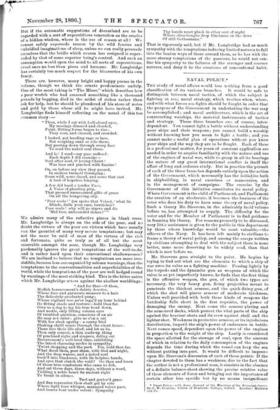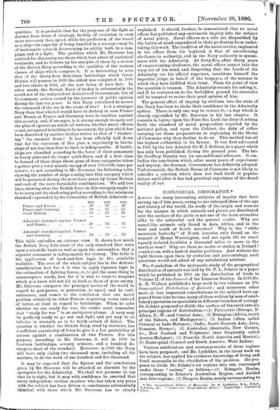NAVAL POLICY.*
THE study of naval affairs would lose nothing from a good classification of its various branches. It would be safe to distinguish between naval tactics, of which the subject is fighting at sea; naval strategy, which teaches when, where, and with what forces sea-fights should be fought in order that the purpose of the Government in undertaking the war may be accomplished ; and naval architecture, which is the art of constructing warships, the material instruments of tactics and strategy. These three branches are, of course, inter- dependent. You cannot fight a battle without understanding your ships and their weapons; you cannot build a warship without knowing how you mean to fight a battle; and you cannot make a useful plan of operations without you know your ships and the way they are to be fought. Each of these is a professional matter, for years of constant application are needed in order to acquire familiarity with the nature and use of the engines of naval war, while to grasp in all its bearings the nature of any great international conflict is itself the affair of long and arduous study. But in practice the pursuit of each of the three branches depends entirely upon the action of the Government, which necessarily has the initiative both in shipbuilding, in naval exercises or manceuTres, and in the management of campaigns. The exercise by the Government of this initiative constitutes its naval. policy. Where Government is the child of Parliament, and Parliament the creation of an electorate, it becomes the business of the voter who does his duty to have some theory of naval policy. Such a theory Mr. Steevens, in the admirably lucicrvolume before us, has attempted to supply. The difficulty for the voter and for the Member of Parliament is to find guidance in framing his theory. For reasons presently to be discussed, very litt:e assistance is given to the public in this department by those whose knowledge would be most valuable,—the officers of the Navy. It has been left mainly to civilians to frame a theory of naval policy, and among the essays written by civilians attempting to deal with the subject there is none better, none more deserving to be widely read, than that which is now before us.
Mr. Steevens goes straight to the point. He begins by trying to find out what are the elements to which a ship of war owes its value as a fighting machine. Passing lightly by the torpedo and the dynamite gun as weapons of which the value is as yet imperfectly known, he finds that the first thing is the offensive weapon, the gun, of which two types are necessary, the very heavy gun, firing projectiles meant to penetrate the thickest armour, and the quick -firir g'gun, of which the shot will pierce armour of moderate thickness. Unless well provided with both these kinds of weapons the battleship falls short in the first requisite, the power of damaging the enemy. Next come the armour plating and the armoured decks, which protect the vital parts of the ship against the heaviest shots and its crew against shell and the lighter shot. Weakness in protective armour, or its injudicious distribution, imperil the ship's power of endurance in battle. Next comes speed, dependent upon the power of the engines in proportion to the weight of the ship. Lastly is considered the space allotted for the stowage of coal, upon the amount of which in relation to the daily consumption of the engines depends the time during which the vessel can keep the sea without putting into port. It would be difficult to improve upon Mr. Steevens's discussion of each of these points: If the chapter devoted to them has a weakness, due to the fact that the author is not a professional man, it consists in the absence of a definite balance-sheet showing the precise relative value of these elements of force and bringing out the importance of certain other less specific but by no means insignificant Nasal : with Some Account of the Warships of the Principal Powers By G. W. Steevens, Fellow of Pembroke College, Oxford. London.: Methuen and CO.
qualities. It. is probable that for the purposes of the fight as distinct from those of strategy, facility of evolution is even more necessary than speed, while the perfection of the vessel as a ship—its capacity of being handled in a seaway—may be of inestimable value in determining its utility both in a cam- paign and in a fight. The qualities which Mr. Steevens has selected for discussion are those which best admit of statistical treatment, and he follows up his analysis of them by a review of the British Navy according to the qualities of the various classes of ships which compose it. It is interesting to note that of the thirty-four first-class battleships which Great Britain will possess in 1899 the oldest was completed in 1886 and two others in 1888, all the rest being of later date. In other words, the British Navy of to-day is substantially the result not of the independent initiative of Government, but of Government action caused by the pressure of public opinion during the last ten years. Is this Nary calculated to secure the command of the sea in the event of war ? Is it a stronger Navy than that which it would have to destroy in case France and Russia or France and Germany were to combine against this country, and, if stronger, is it strong enough to carry out the plan of operations which all writers, whether naval officers or not, are agreed in holding to be necessary, the plan which has been described by another civilian writer as that of " shadow- irtg " the enemies' fleets ? It has been officially laid down that for the execution of this plan a superiority in battle- ships of not less than four to three is indispensable. If battle- ships are classified according to the force of their armament in heavy guns and the larger quick-firers and if a first class be formed of those ships whose guns of these categories taken together give a total muzzle energy of over 150,000ft.-tons per minute, we get, according to Mr. Steevens, the following table showing the number of ships coming into this category which will be possessed during the next three years by Great Britain and each of the more formidable combinations. We add two lines, showing what the British force in this category ought to be to carry out the shadowing policy according to the minimum standard expounded by the Committee of British Admirals
1897. 1898. 1899.
France and Russia ... 20 ... 24 ... 28 France and Germany . . 19 ... 21 ... 25 Great Britain... ... 18 ... 22 ... 25
Admirals' standard against France
and Russia... ... ... 27 ... 32 ... 37 Admirals' standard against France
and Germany ... ... 25 ... 28 ... 33 This table embodies an extreme view. It shows how much the British Navy falls short of the only standard that rests upon a scientific basis as well as upon the assumption that a superior armament is indispensable for victory. The table is the application of hard-and-fast logic to the available statistics. The crux of the whole subject lies in the delicate consideration how far it is wise to apply rigorous logic in the estimation of fighting forces, or, to put the same thing in commonplace words, how far it is wise to trust to weapons which you know will not bit as hard as those of your enemy. Mr. Steevens compares the principal navies of the world in regard to gun-power, to protection, to speed, and to coal. endurance, and comes to the conclusion that our naval position relatively to other Powers is growing worse instead of better, at least in regard to battleships. When he asks whether we are ready for war, the reader must remember that "ready for war" is an ambiguous phrase. A navy may be perfectly ready to go out and fight, and yet may be so inferior in strength as to bz fairly certain of defeat. The question is whether the British Navy, tried by statistics, has a sufficient superiority of force to give it a fair probability of success against a combination of two Powers. For this purpose, according to Mr. Steevens, it will in 1899 be fourteen battleships, seventy cruisers, and a hundred de- stroyers short of the standard. Moreover, in 1899 the Navy will have only eighty-two thousand men, including all the marines, to do the work of one hundred and five thousand.
It may be expected that the figures and the conclusions given by Mr. Steevens will be attacked as alarmist by the • apologists for the Admiralty. We shall not presume to say that he is right, but it may with confidence be asserted that every independent civilian inquirer who has taken any pains with the subject has been driven to conclusions substantially identical with those which Mr. Steevens has so clearly explained. It should, further, be remembered that no naval officer has published any systematic inquiry into the subject of naval policy. Naval officers as a rule are disqualified by the habits of mind engendered in their profession from under- taking this work. The tradition of the naval service, implanted in the officer from his boyhood, is that of uncriticising obedience to authority, and in the Navy authority is synoni- mous with the Admiralty. At forty-five, after thirty years of unquestioning obedience, the naval officer cannot take the warp out of his mind, and, forgetting that the Lords of the Admiralty are his official superiors, constitute himself the impartial judge, in behalf of the taxpayer, of the manner in which they have fulfilled their trust. From his point of view the question is treason. The Admiralty resents his asking it, and if he ventures on to the forbidden ground his comrades will be tempted to revise their good opinion of him.
The general effect of inquiry by civilians into the state of the Navy has been to shake their confidence in the Admiralty system. There is only one way to restore it,—a way which is clearly expounded by Mr. Steevens in his last chapter. It consists in laying upon the First Sea Lord the duty of setting forth the standard of naval preparation required by the national policy, and upon the Cabinet the duty of either carrying out those preparations or explaining to the House of Commons why they decline to do so. This method has all the highest authorities in its favour. It was first advocated in 1861 by the late Admiral Sir B. J. Sulivan, in a paper which has only been published during the present year. The late Sir Geoffrey Hornby was its unconditional advocate. It em- bodies the conclusion which, after many years of experiment and inquiry, the German Government has definitely adopted. Unfortunately, the British House of Commons is not likely to consider a question which does not lend itself to popular debate until after it has had practical experience of the dread reality of war.











































 Previous page
Previous page